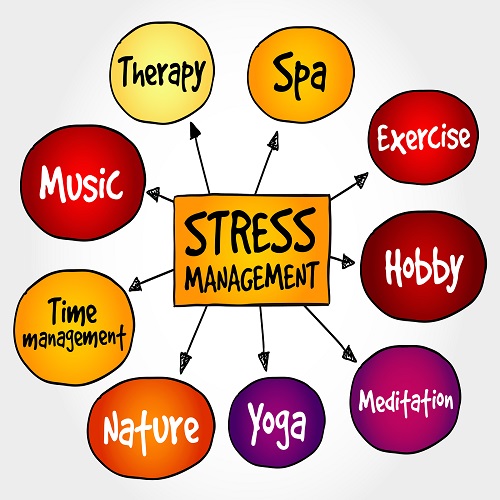Stress Management: An Integrative Approach to Therapy
Overview
“What is the point in narrating the whole sad story to yet another therapist who is there just to listen? They can’t change the reality of my life. It will bring back all the bad memories and I will end up feeling worse than how I am feeling now,” this is the sentiment some clients express.[1] However some other clients say just the opposite,
“Thank God I was able to discuss all my problems with the therapist who really understood me, and after discussing my problems I am able to see things in a different light now.”
Even in the military settings we find that some soldiers, after being in combat settings, find debriefing with their colleagues helpful, whereas others end up feeling worse and they want to rely on their sleep and other natural healing to feel better. How do we understand this difference?
Perhaps those who report a benefit from debriefing sessions have already acquired the ability to process their negative emotions, whereas others are not as yet good at confronting their painful emotions and making good use of a conscious reflection on their own. It is therefore important that members of the second group first learns certain coping strategies in dealing with their emotions before embarking on an exploratory psychotherapy, otherwise they will have to rely heavily on their therapist for interpretation, emotional support through relationship, guidance and finding meaning in their symptoms, and their progress with therapy would be slow.
This paper discusses an integrated therapy model which equips clients with a number of different coping strategies that they can employ to swiftly move into a deeper exploration of their psyche either in therapy settings or on their own. It has been the experience of the author that some client, who suffer from mild symptoms, don’t even feel the need for further therapy sessions after attending this six-session stress management programme, as they are able to work on the problems on their own. It’s like someone has learnt well how to row the boat and now it’s a matter of start sailing, they may still need an odd session to help them with difficult, unexpected situations for which the therapist should be available to provide support.
This programme therefore can be seen as a preparation for therapy i.e. psychoeducation as well as therapy in itself. Secondly, as there are philosophical and spiritual elements in this programme, it can help even those who do not suffer from any psychiatric problems as it addresses the issue of normal human suffering.
The Therapy Goals:
The goals of therapy vary from therapy to therapy, some therapies seek to give insight through interpretation and also give direction, and “enhanced awareness” of the client is seen as an outcome, whereas other therapies seek to enhance clients’ awareness, and gaining insight is seen as the natural outcome. Both approaches are valid and can complement each other. Instead of seeing the insight and enhanced awareness as a linear progression if we saw them as a circular feedback loop, then it won’t be difficult for us to see how both feed into each other, insight leads to enhanced awareness and enhanced awareness to insight.
The client-centered therapy seeks to free the client from their emotional stuckness but won’t help them with the decision making or direction[2], whereas interpretive approaches help clients with that as well as symptom removal, both are valid approaches if we fully understand the dynamics of change happening in therapy.
When experiencing a negative emotion, one tends to exaggerate the negative and deny the positive. Whereas in a happy frame of mind one tends to exaggerate the positive and deny the negative. This compromises the individual’s ability to see the reality as it is, and as a result their ability to deal with it. With this in mind one can say that, from a stress management point of view, the mind is at its best when it is equanimous – emotionally neutral. An emotionally neutral mind is able to perceive reality as it is, it can make appropriate judgments and also carry out appropriate actions.
The goal of this programme is to take the client from an emotionally unsettled mental state to an emotionally neutral (equanimous) state so that they are able to interpret for themselves and take the most appropriate actions. In this respect equanimity is seen here as the tool, the path and also the goal of therapy in this programme.
The three Domain of Psyche
Traditionally the mind has been divided into the three domains of thoughts, emotions, and behaviour. Taking into consideration the recent scientific explorations within the field of mindfulness meditation one can consider a fourth domain of inner body sensation. Different therapies focus on different domains i.e. cognitive therapy, transactional analysis and psychoanalysis on the thoughts; the experiential therapies, client centred therapy and music therapy focus on the emotions; behavioural therapies, psychodrama and gestalt therapy focus on behaviour; and mindfulness meditation and autogenic training on the inner body sensations.
According to cognitivists thoughts are primary and emotions and behaviour secondary. They argue that even the therapies such as client-centered approach, that brings about a change in emotions, uses non-judgmental approach and works with cognitions to effect change.
The experiential therapists believe that emotions are primary and thoughts and behaviour secondary. According to them emotions colour our judgements and imprison our thoughts; an alcoholic who drinks or a boy who steals know that it is wrong to drink or steal, this insight doesn’t help them because of the emotional gratification they get out of the activity. It’s only when they are able to handle their emotions and let go of the gratification, they can come out of it.
Contrary to the above two points of view, behaviourist believe that behaviour should not be viewed as an epiphenomenon of thoughts and emotions but should be studied as a subject matter in its own right. For example, no amount of arm-chair speculation will help one overcome stage freight. One has to go and stand up on the podium and start speaking in order to overcome this fear, and in this process they would have overcome their negative cognition or emotions.
The semantic network models:
According to the semantic network theories discussed by Greenberg and Safran (1987) no single domain is more basic or primary, the different domains are joined together into a cause and effect relationship, and activation of one spreads to the others.[3] This provides a theoretical framework for integrating various therapies. As the activation in one domain spreads to the others, it doesn’t matter where the activation starts as it will spread to the whole network. And activation at two different points simultaneously will make the therapy more effective. I have tried to incorporate sensations as the fourth domain of psyche in the semantic network model (appendix 1 attached).
Another theoretic framework that can help us understand the logic behind integration is the understanding of the change process in therapy in terms of a final common pathway. If a change has occurred in therapy, irrespective of which therapy was employed, the underlying process has to be the same. This change process has been described as the final common pathway. It may be that different therapies play different roles at different stages of this common final pathway, and on that basis one can employ more than one therapies at one time for better efficacy.
The Final Common Pathway: It consists of the following stages:
Activation (decoding) of the past experiences.
Reliving the past experiences.
Integration of a corrective therapeutic experience with it.
Transformation of the experience.
Re-recording (recoding) of the new experience in the mind.
The problems with Integration:
Is it possible to mix together two seemingly opposite therapy approaches? In recent years an inconvenient marriage between mindfulness meditation and cognitive therapy has worked well in spite of the fact that one is interpretive and the other one non-interpretive. One aims to alter the cognitions and the other encourages us to leave them alone. Logically they can’t be combined just as one can’t play football and chess at the same time, but one can play them at two different times of the day.
The final common pathways also help us understand the ways in which certain therapies can be combined as different therapy approaches play different roles at different stages of this change process.
However, one should not combine therapies that seek to achieve opposite results i.e. suppressing the unconscious or opening it up, creating new positive emotions or working on the old negative emotions, strengthening the defence mechanisms or breaking them down etc.
The Integrative Attempts:
The integration of therapies was first attempted in the form of CBT, and a number of different therapy approaches were developed later on. In the United Kingdom Anthony Ryle[4] integrated analytic understanding into cognitive therapy and developed cognitive analytic therapy (CAT) and Teasdale et al (2002) have incorporated mindfulness meditation into cognitive practices and developed Mindfulness Based Cognitive Therapy (MBCT)[5]. Similarly in the United States, Jon Kabat-zinn has developed Mindfulness Based Stress Management[6] and Marsha Linehan (1993) has developed Dialectic Behavioural Therapy by incorporating elements of Zen meditation into Cognitive Behavioural Therapy[7]. The other examples of integrative approach in recent times would be Dynamic-interpersonal therapy, Acceptance and Commitment Therapy and Compassion-based therapies.
The integration achieved in this programme
This paper discusses how the author has incorporated ideas from a variety of different spiritual and therapy approaches, not just from Vipassana meditation but from existential psychotherapy, biofeedback therapy, CBT, psychodynamic and interpersonal therapies etc, and has created a six-session stress management programme that has proved effective in treating a number of psychiatric disorder such as anxiety, depression, OCD, phobias, relationship problems, eating disorders, work-related stresses etc. This programme is delivered in the form of six weekly sessions individually or in groups.
This programme starts with explaining to the client the structure of the mind and how it works, how emotions are processed and how they can be neutralised, how to be less judgmental and detached from the contents of one’s mind, and how spiritual ideas can be combined with modern electronic devices in managing one’s negative emotions.
Those who are interested in learning further can download six audio as well as video sessions on stress management free of charge from the website www.undoyourstress.com. This paper only provides an outline of the programme.
The mindfulness meditation as practised in the West doesn’t seems to capture all the essential elements of this practice. It is the view of the author that one can go a step further and incorporate the hitherto ignored aspects of mindfulness meditation such as the principle of impermanence and non-identification. These can be seen as corrective therapeutic experiences that can be used at the point of reliving the old experiences. Secondly, there is hardly any talk about how the proponents of mindfulness meditation understand the mind, which is quite different from the understanding of the Western psychology. The programme discussed here has incorporated those aspects of mindfulness meditation.
An attempt has been made to combine biofeedback therapies with traditional psychotherapy for a greater efficacy.
This programme also attempts to integrate elements of existentialism and spirituality into the fold of psychotherapy. The phenomenological approach of existentialism won’t be inconsistent with the mindfulness meditation as they both encourage clients to get connected with their inner state of affairs without making any interpretations or judgment or having emotional reactions. However, these approaches cannot and should not be clubbed together with the interpretive approaches such as psychoanalysis or cognitive therapies, but they can still be practised by the same individual at different times. It’s very much like a therapist being very judgmental with their spouse in the morning and adopting a non-judgmental approach in therapy with their clients later on during the day. This switch is possible.
Non-directive elements:
The goal of this program is to help the individual handle their emotional upset so that they regain their equanimity and after that it is left to the individual to carry out the appropriate action. In this respect it is similar to Rogerian client-centered therapy. It helps clients neutralise their emotionally charged experiences and regain their equanimity, and the assumption here is that an equanimous client will know how to correct their cognitive errors.
Using a purely cognitive approach would be like teaching a child who has injured his leg how to walk. The child knows how to walk, all we need to do is to help him with healing of the injury and once healed he will be able to walk by himself. The same logic can be applied to cognitive errors as well. It’s the emotionally disturbed state, among other things, that results in wrong judgements and inappropriate actions. Therefore, an attempt should be made to help the person regain their emotional balance and they will be able to correct their cognitive errors by themselves.
This programme can be seen as primarily psychoeducational, but it has a number of other elements as well, some of them will qualify as conventional therapy. One learns to reduce demands placed upon themselves. A holistic way to relax discussed by the author can help clients learn new ways of making the best possible use of their me/down time.[1]
Adopting a non-judgemental attitude or suspending and bracketing one’s judgments for short periods of time can be seen as a strategy in minimising cognitive errors. An attempt at the synthesis of the opposites can also help clients minimise their cognitive errors.
This programme is therefore a careful blend of techniques that don’t antagonise or nullify the effects of each other.
The Sessions
Stress has been defined as the gap between the demands placed on an individual and the individual’s ability to cope with it. With this in mind, management of stress can be understood under two broad headings:
To reduce the demands placed on the individual by way of lifestyle changes.
To increase their coping abilities using a number of different cognitive, experiential and behavioural techniques.
Session 1: The Causes of Stress – Similar to the cognitive therapy model, judgemental errors are seen in this programme as the main cause of stress, and they are discussed under the following five categories:
- All judgements are relative, not absolute.
- We haven’t got the full information as yet. The catch phrase here is – “I haven’t got the full picture yet.”
- We can’t look into the future, our judgments may need revising in future.
- Moving from global to specific judgements i.e. we tend to see things in terms of black and white whereas the reality invariably lies somewhere in the middle grey zone.
- Synthesis of the opposites, along the lines of Eastern philosophy and Jungian approach to therapy.
By following this approach, one is able to become less judgemental or suspend one’s judgement for short periods of time so that they can see the reality as it is. The other causes of stress discussed are – our inability to accept change that is happening all the times and wanting to be in control of our lives all the time.
The clients are introduced the principle of impermanence along the lines of mindfulness meditation. Clients are also introduced to paced breathing using certain mobile phone apps.
Session 2: Understanding the Mind – This session is devoted to discussing the structure and functioning of the mind that can help clients make sense of their symptoms, here the author has borrowed heavily from psychoanalysis. Clients are explained how emotions are produced, how they are processed during the day and worked through by reflecting on their everyday experiences and understanding them from a different perspective, and eventually how they are neutralised. However, when these emotions go into the unconscious mind they come back into the conscious mind sometime in future. As explained by Sigmund Freud, clients understand the mind in terms of a fountain, the water that we can be seen is the conscious mind, and that we can’t is the unconscious, and they are in constant circulation, what is conscious today will become unconscious tomorrow and what is unconscious today will become conscious tomorrow. In view of this one can understand one’s spontaneous and automatic emotions and thoughts as a constant expression of their unconscious mind and this can explain panic attacks, phobias, OCD, depression, paranoia etc. This constant expression of unconscious mind can also explain the vague unexplained bodily symptoms that come out of the blue. Clients learn to identify these as ghost emotions[8] and learn not to react to them emotionally.
Clients are introduced to a breath awareness technique as practised in mindfulness meditation and encouraged to practice it at least 10 minutes twice daily. They are also explained how to write an emotion diary.
Session 3: Non-identification: The concept of non-identification has been described in ancient Indian scriptures and also in Buddhist texts. This relates to the idea that we are not the mind, but we have a mind. Although the Western concept of the mind includes everything psychological about a person, the Eastern concept talks about a very narrow concept of the mind referring to the intellect i.e. thinking-judging-feeling-and-reacting part of our Being. Existentialism also acknowledges the presence a part of our Being which is beyond the everyday intellect which is non-judgmental, non-reacting and reflecting consciousness, very much like a mirror that doesn’t make any judgments but shows everything. This has been loosely described by Heidegger as Dasein. In modern times non-identification has been discussed by Ramana Maharishi[9], Nissargadatta[10], Eckhart Tolle[11], Byron Katie[12], etc. Following this approach one starts saying to oneself about the negative emotions, “this is not the real me”.
This programme discusses how one can dis-identify with one’s thoughts and feelings. This approach has its roots in Eastern philosophy of not identifying with one’s own intellect or thinking,-judging-and-analysing part of the mind. This can help the client not react to what’s going on in their mind and not create new negative emotions.
Session 4: Psychophysiology of Stress and Biofeedback Therapy: Clients are introduced to the concepts of heart rate variability and brain entrainment and how, by way of breath control or use of heart rate variability software, one can increase one’s heart rate variability. They also learn how to change their brain wave pattern using light and sound machines and increase the alpha and delta waves in their brain.
A practical demonstration of abdominal or diaphragmatic breathing helps them regulate their autonomic nervous system by way of synchronising parasympathetic nervous system with the sympathetic nervous system.
Session 5: Understanding of Psychoanalysis and Existentialism: clients are introduced to the idea of unconscious mind and its role in symptom formation, and a discussion on existential philosophy helps them understand the structure of “Being”.
- Existence v essence
- Ontological v ontic unhappiness
- Loneliness and mutuality
- Freewill, choice and responsibility
- Death desensitisation
- Definition of normalcy
- Authenticity
- Meaning in relationships
- Purpose of life etc.
After attending this session clients are able to give up their romanticised view of the world and see human life in its true nature. Clients learn from Sartre’s philosophy how they have compromised on their authenticity by way of being in bad faith and in relationships[13]. They learn how to gain authenticity through Martin Buber’s description of I-It and I-Thou relationships[14] and also learn from Lacan’s philosophy how to overcome a feeling of a constant lack[15]. Reflecting on the question – what are the ingredients of a normal life? makes them more accepting of their predicaments. A discussion on the Indian concept of the four goals of life – money, sensual pleasures, duty and liberation from suffering motivates them to fulfil their duties to their family, friends, neighbours, countrymen and international community.
Session 6: Inner Peace and Spiritual Values: In the West science grew as a revolt against religion whereas in the East religion has never been in conflict with the science. Here the author has tried to incorporate elements from the Eastern as well as the Western ideas of spirituality. Certain spiritual values and practices that can help people with their stress symptoms are discussed, such as seeking solitude, truthfulness, authenticity, forgiveness, tolerance, friendliness, surrender to the laws of the universe and to that of the psyche, being in awe and wonder of the infinite and finding a meaningful connection with that infinite are discussed with the client.
This programme can be seen as the first step towards a deeper exploration of the psyche. It can form a starting point for a variety of different forms of therapies. This programme is not just for psychiatric patients but for normal human beings as well who want to work on their everyday normal human suffering.
References
Chandiramani, K., Emotions and Stress: How to manage them. 2016: Partridge Publishing.
Rogers, C., Client-centered therapy. . Psychotherapists Case Book: Theory and technique in practice ed. I.L. Kutash and A. Wolf. 1986, San Francisco: Jossey-Bass.
Greenberg, L.S. and J. Safran, Emotion, cognition, and action, in Theoretical foundations of behavior therapy. 1987, Springer. p. 295-311.
Ryle, A.E., Cognitive Analytic Therapy: Developments in theory and practice. 1995: John Wiley & Sons.
Teasdale, J.D., et al., Metacognitive awareness and prevention of relapse in depression: empirical evidence. Journal of consulting and clinical psychology, 2002. 70(2):
Kabat‐Zinn, J., Mindfulness‐based interventions in context: past, present, and future. Clinical psychology: Science and practice, 2003. 10(2): p. 144-156.
Linehan, M.M., Dialectical behavior therapy for treatment of borderline personality disorder: implications for the treatment of substance abuse. NIDA research monograph, 1993. 137: p. 201-201.
Chandiramani, K., Session 3 – Non-identification, www.undoyourstress.com 2020.
Maharshi, R., The spiritual teaching of Ramana Maharshi. 2004: Shambhala Publications.
Maharaj, N., I am that: Talks with Sri Nisargadatta Maharaj. 2012: Acorn Press.
Tolle, E., A new earth: create a better life. 2009: Penguin UK.
Katie, B., The Work of Byron Katie. Manhattan Beach, CA, 2014.
Detmer, D., Sartre explained: From bad faith to authenticity. Vol. 6. 2008: Open Court Publishing.
Buber, M., Martin buber. Information Theory, 1968: p. 122.
Driver, M., Struggling with lack: A Lacanian perspective on organizational identity. Organization Studies, 2009. 30(1): p. 55-72.
© Kishore Chandiramani, Consultant Psychiatrist
Emotions Clinic, Education and Training Centre Cic, Staffordshire, England
www.undoyourstress.com





